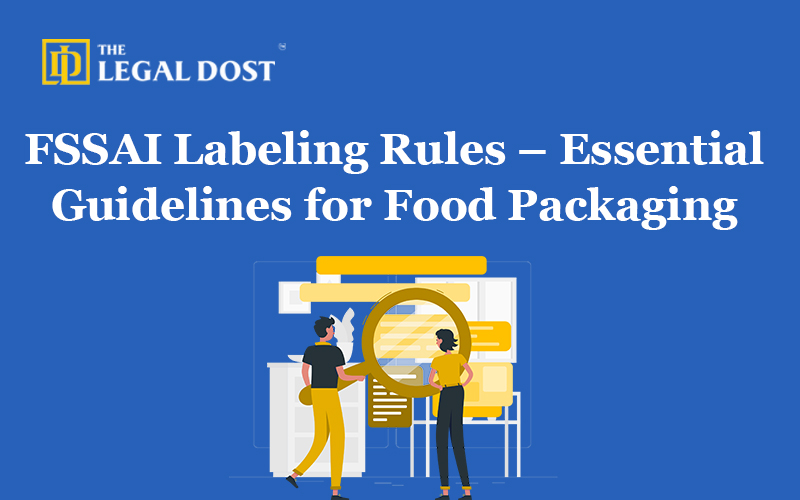Government agencies worldwide enforce stringent FSSAI labeling rules to ensure food safety and transparency. In India, the Food Safety and Standards Authority of India (FSSAI) governs food labeling and packaging standards. Whether launching a new food product or updating packaging, businesses must adhere to food packaging FSSAI guidelines to avoid penalties, recalls, or delays. Understanding FSSAI label requirements is crucial for ensuring compliance and market readiness.
Key FSSAI Labeling Requirements for Packaged Foods
The FSSAI regulations for food labels mandate that every packaged food item must include specific details to inform consumers and ensure transparency. Below are the essential elements every food label must contain:
Product Name: The label must prominently display the name of the food product as per FSSAI label size & font specifications.
Ingredient List: The FSSAI rules for ingredient listing require manufacturers to disclose all ingredients used, ensuring consumers are not misled.
Nutritional Information: A nutrition label FSSAI must include energy (calories), fats (including trans and saturated fats), sodium, cholesterol, fiber, carbohydrates, protein, sugars, iron, calcium, and essential vitamins.
Vegetarian or Non-Vegetarian Declaration: A FSSAI-compliant packaging must indicate the food type using a green dot (vegetarian) or a red dot (non-vegetarian).
Food Additives: Any additives used to enhance flavor or appearance must be declared.
Manufacturer’s Name & Address: The full name and address of the manufacturer must be clearly stated.
Customer Care Details: Consumer support contact information must be included.
Net Quantity: The label must specify the net weight or volume of the product.
Retail Price: The Maximum Retail Price (MRP) must be clearly mentioned.
FSSAI Logo and License Number: The FSSAI logo on food labels and the license number must be displayed prominently.
Batch/Code/Lot Number: This provides authenticity and traceability for the product.
Manufacturing & Expiry Dates: The label must state the manufacturing date and a “Best Before” or “Use By” date to inform consumers about the product’s shelf life.
Usage Instructions: Directions for safe consumption, storage, and preparation must be included.
Country of Origin: For imported food products, labels must specify the country where the food was grown, processed, or manufactured.
Barcode Requirements FSSAI: A scannable barcode should be present on food labels for tracking and inventory purposes.
FSSAI Labeling Guidelines for Specific Food Categories
Wholesale Packages:
Labels must include:
- Product name
- Ingredient list (if applicable)
- Manufacturer’s details
- Manufacturing date
- Expiry date
- Vegetarian/non-vegetarian logo
- Importer’s details and FSSAI importer license number
Primary Foods in Packages:
Labels must contain:
- Food name
- Packer’s details
- Packing date
- Importer’s details (if applicable)
- Net weight
- Batch/Lot/Code Number
- Expiry date
- FSSAI logo on food labels
Primary Foods Imported in Bulk:
Labels should display:
- Food name
- Importer’s details
- Net weight
- Batch/Lot/Code Number
- Expiry date
- Durable labels on packaging (e.g., sacks or gunny bags)
Exemptions from FSSAI Food Labeling Rules
Certain products are exempt from full compliance with FSSAI label requirements:
- Small packages (<100 cm²) may omit some details.
- Tiny packs (<30 cm²) can shift details to outer boxes.
- Reusable liquid bottles need only nutrition label FSSAI information.
- Perishable foods (<7-day shelf life) need only a “Use By” date.
- Wholesale packages may omit ingredient lists and expiry dates.
Common Mistakes That Can Delay FSSAI Approval
To ensure smooth approval, avoid these common errors in FSSAI compliance packaging:
- Font Issues: Use the correct FSSAI label size & font for clarity.
- Logo Errors: Ensure the FSSAI logo on food labels meets size and color specifications.
- Low Contrast: Ensure good contrast between text and background for readability.
- Misleading Claims: Avoid false health claims that violate FSSAI regulations for food labels.
- Nutritional Data Misplacement: Essential nutrition label FSSAI details must be visible on the front.
By strictly following FSSAI labeling rules, manufacturers can ensure compliance, build consumer trust, and avoid legal issues. Before printing, always verify labels against the latest food packaging FSSAI guidelines to ensure regulatory approval.
Conclusion
In conclusion, FSSAI labeling requirements are crucial for ensuring transparency and consumer safety in packaged foods. By adhering to these guidelines, manufacturers can provide clear, accurate information about ingredients, nutritional value, and product authenticity. Compliance not only helps build trust but also prevents legal complications. It’s essential for manufacturers to stay updated on the latest FSSAI guidelines and avoid common errors to ensure smooth approval and consumer confidence.
FSSAI Labeling Rules – Essential Guidelines for Food Packaging (FAQ)
Labels must include product name, ingredient list, nutritional information, manufacturer details, net quantity, retail price, FSSAI logo and license number, batch number, expiry date, and usage instructions.
Yes, all packaged food labels must display the FSSAI logo and license number.
Yes, small packages (<100 cm²) may omit some details, while tiny packs (<30 cm²) can shift information to outer boxes.
A green dot indicates vegetarian food, while a red dot indicates non-vegetarian food.
Yes, perishable foods with a shelf life of less than 7 days only need a “Use By” date.
Wholesale packages must include product name, manufacturer details, manufacturing and expiry dates, vegetarian/non-vegetarian logo, and FSSAI importer details.
No, misleading health claims are prohibited under FSSAI regulations.
Avoid font issues, logo errors, low contrast, misleading claims, and improper placement of nutritional data.


